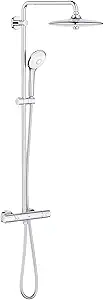How a Thermostatic Shower Works (And How to Fix It): A Plumber’s Guide
We’ve all been there. You’re enjoying a perfect shower when suddenly a toilet flushes elsewhere in the house, and you’re hit with a blast of scalding hot water. Or someone starts the dishwasher, and your warm stream turns into an icy shock. For decades, this was just an unpleasant fact of life. But modern plumbing has a brilliant solution: the thermostatic shower.
As a licensed plumber with over 15 years of experience installing and repairing residential water systems, I’ve seen firsthand how a quality thermostatic valve can transform the daily shower from a gamble into a guaranteed luxury. It’s one of the single best upgrades for safety and comfort you can make in your bathroom. This guide will demystify exactly how these clever devices work, what to do when they don’t, and how to choose the best one for your home.
What’s a Thermostatic Shower, Anyway?
A thermostatic shower isn’t the showerhead or the faucet handle; it’s the advanced mixing valve hidden in the wall behind the controls. Its sole purpose is to maintain the water temperature you’ve selected, regardless of changes in the hot or cold water supply pressure or temperature.
It differs from other common valve types:
- Manual (Single-Handle) Valves: These are the most basic type. The handle position simply controls the ratio of hot to cold water. If the hot water pressure drops, the ratio changes, and you get scalded. There is no automatic adjustment.
- Pressure-Balancing Valves: These are a step up and are required by plumbing code in many areas for safety. They sense the *pressure* of the hot and cold water lines. If the cold water pressure drops (from a toilet flush), the valve automatically reduces the hot water pressure to match, preventing a dangerous temperature spike. However, it doesn’t control the actual temperature, only the pressure ratio.
- Thermostatic Valves: This is the premium option. A thermostatic valve directly senses and controls the *temperature* of the mixed water. It automatically adjusts the hot and cold water mix to maintain a constant, precise temperature, providing the highest level of safety and comfort.
How a Thermostatic Shower Valve Works: The Magic Inside
From the outside, you just have a dial for temperature and a lever for water flow. But inside the valve’s brass body, a sophisticated mechanical process is constantly at work. The heart of the system is the thermostatic cartridge.
Think of it like the thermostat for your home’s HVAC system, but for water, and reacting in milliseconds. Here’s a breakdown of the process:
1. The Thermo-Sensitive Element
The core component is a small, sealed capsule containing a special type of wax (or sometimes a bimetallic coil). This wax has been precisely engineered to expand or contract based on the temperature of the water flowing past it.
2. The Piston and Sleeve Mechanism
This wax element is connected to a small piston or slide valve that sits inside a sleeve. The sleeve has ports that allow hot and cold water to enter the mixing chamber. The piston’s position determines how much of each port is open or closed.
3. The Balancing Act
- When you turn the temperature dial, you are setting a baseline position for this piston.
- As water flows, the wax element heats up or cools down to the mixed water temperature.
- If the water gets too hot (e.g., someone uses cold water elsewhere), the wax expands. This expansion pushes the piston forward, partially closing the hot water port and opening the cold water port wider. More cold water enters the mix, bringing the temperature back down to your set point almost instantly.
- If the water gets too cold (e.g., the water heater is struggling), the wax contracts. This pulls the piston back, closing the cold water port and opening the hot water port wider until the temperature is correct again.
This entire process is purely mechanical and happens continuously throughout your shower, making tiny adjustments to maintain a stable temperature within ±1°F.
Key Takeaway
A thermostatic valve uses a heat-sensitive wax element to physically move a piston, automatically and instantly adjusting the hot/cold water mix to hold your desired temperature perfectly steady. It’s a proactive, temperature-based system, not a reactive, pressure-based one.
How to Adjust a Thermostatic Shower Valve
Sometimes, the temperature on the dial doesn’t match the actual water temperature. This usually means the handle was installed incorrectly or the valve’s maximum temperature stop needs calibration. Adjusting it is a simple DIY task.
-
Access the Valve Stem. First, you need to remove the temperature control handle. This is usually done by prying off a small decorative cap (with a small flathead screwdriver) to reveal a set screw. Loosen the screw (typically with an Allen key or Phillips screwdriver) and pull the handle straight off.
-
Find the Rotational Stop. Once the handle is off, you’ll see a plastic or metal ring around the valve stem. This is the high-temperature limit stop. Its job is to prevent the handle from being turned to a dangerously hot setting. It usually has splines or teeth that engage with the handle and a mechanism to limit how far it can turn.
-
Calibrate the Temperature. Turn on the shower and let the water run until it’s at its maximum hot temperature. Use a reliable thermometer (a digital kitchen thermometer works well) to measure the temperature of the water coming from the showerhead. Most safety codes recommend a maximum of 120°F (49°C).
-
Set the Limit Stop. Pull the limit stop ring off, rotate it, and then place it back on so that it physically stops the valve stem from turning any further at that 120°F position. This sets the new maximum safe temperature.
-
Reinstall the Handle. Turn the water off. Place the handle back onto the stem, ensuring the temperature indicator on the handle aligns correctly with the temperature markings on the wall plate (escutcheon). Tighten the set screw and replace the decorative cap. Test your work to ensure the temperature is comfortable and safe.
How to Remove & Replace a Thermostatic Shower Valve Cartridge
If your shower has low flow, a constantly dripping head, or fails to regulate temperature properly, the cartridge is the most likely culprit, especially in areas with hard water. Replacing it is an intermediate DIY job that can save you a significant plumbing bill.
Safety First: Shut Off The Water!
Before you begin any work, locate the main water shut-off valve for your house and close it completely. Then, open the shower faucet and another faucet in the house (like a sink) to drain any remaining water from the pipes. Failure to do this will result in a major flood in your bathroom.
Tools You’ll Need:
- Phillips & Flathead Screwdrivers
- Set of Allen Keys (Hex Wrenches)
- Adjustable Wrench or Channel-Lock Pliers
- Utility Knife
- Flashlight or Headlamp
- White Vinegar & a Small Brush
- Plumber’s Grease
- The correct replacement cartridge

Pro-Tool Recommendation: Cartridge Puller
While not always required, a dedicated cartridge puller tool can be a lifesaver, especially for cartridges that are badly stuck due to age or hard water. This tool is designed to grip the cartridge securely and use leverage to pull it straight out without damaging the valve body. For Moen valves, this Danco puller is an industry standard.
Check Price on AmazonStep-by-Step Cartridge Replacement Guide
-
Remove Handles and Trim Plate. Follow the steps above to remove the temperature and flow control handles. Next, remove the large decorative wall plate (escutcheon). It may be held on by screws or simply caulked and press-fit onto the valve body. If it’s caulked, carefully run a utility knife around the edge to break the seal before prying it off gently.
-
Expose the Cartridge. With the trim removed, you’ll see the brass valve body in the wall and the end of the cartridge. There might be a metal sleeve or bonnet nut holding the cartridge in place.
-
Remove the Retaining Clip/Nut. Many cartridges are held in by a small retaining clip at the top. Use a flathead screwdriver or needle-nose pliers to pull this clip straight up and out. Other models use a large threaded bonnet nut that you’ll need to unscrew with pliers or a wrench (turn counter-clockwise).
-
Remove the Old Cartridge. This can be the trickiest part. Grip the stem of the cartridge firmly with pliers and pull straight out. If it’s stuck, this is where the cartridge puller tool becomes invaluable. Be patient and apply steady pressure.
-
Clean the Valve Body. Once the old cartridge is out, inspect the inside of the brass valve body. Use a small brush and some white vinegar to scrub away any mineral deposits or debris. A clean housing is essential for the new cartridge to seal properly. Wipe it clean with a rag.
-
Install the New Cartridge. Lightly lubricate the O-rings on the new cartridge with plumber’s grease. Carefully align the new cartridge (referencing your photo!) and push it straight into the valve body until it seats fully.
-
Reassemble and Test. Re-insert the retaining clip or screw on the bonnet nut. Turn the main water supply back on SLOWLY and check for any leaks around the cartridge. If all is dry, re-install the trim plate and handles, calibrate the temperature stop as described earlier, and enjoy your perfectly functioning shower!
Pro Tip
Take a clear photo of the exposed cartridge and any retaining clips with your phone. This is an invaluable reference for reassembly, especially for remembering the orientation of the cartridge.

Example Replacement Cartridge: Moen 1222
It is CRITICAL to buy the exact replacement cartridge for your valve’s make and model. One of the most common in US homes is the Moen 1222 Posi-Temp cartridge (note: this is pressure-balancing, but the replacement process is similar for thermostatic models). Always verify your model before purchasing.
Check Price on AmazonWhat Thermostatic Shower is Best? A Buyer’s Guide
Choosing the “best” thermostatic shower depends on your budget, style, and existing plumbing. For a detailed comparison of specific models, you can read our complete guide to the best thermostatic shower systems. But in general, since you can’t see the most important part (the valve), brand reputation and build quality are paramount.
- Top-Tier Brands: Companies like Grohe, Hansgrohe, Kohler, and Moen have decades of engineering experience and are known for producing reliable, high-quality brass valves and cartridges that last. They offer excellent warranties and readily available replacement parts.
- Valve Construction: Look for a valve with a solid brass body. This ensures durability and longevity. The cartridge itself will have plastic components, but the housing should be metal.
- Features to Look For: Anti-scald protection, separate flow and temperature controls, and a style/finish that matches your bathroom.

Plumber’s Recommendation: Grohe Thermostatic System
When clients ask for a top-of-the-line, reliable system, I often recommend Grohe. Their German engineering is exceptional. This Grohtherm system features a true thermostatic valve, separate push-button controls for volume, and a sleek, modern trim plate. It’s an investment, but one that pays off in safety and performance for years.
Check Price on AmazonFrequently Asked Questions (FAQs)
How to fit a thermostatic shower?
Fitting a complete thermostatic shower system from scratch is a major plumbing job that involves opening the wall, cutting and soldering pipes, and ensuring the valve is installed at the correct depth. While the replacement of a cartridge is DIY-friendly, I strongly recommend hiring a licensed plumber for a new installation. An incorrect installation can lead to major leaks inside your walls, incorrect temperatures, and other serious issues.
Thermostatic vs. Pressure-Balancing: Is it worth the extra cost?
In my opinion, yes. While a pressure-balancing valve provides good anti-scald protection, a thermostatic valve provides a superior comfort experience. It maintains the actual temperature, not just the pressure ratio. This means your shower temperature won’t dip if your water heater temperature fluctuates, giving you a more consistent and luxurious experience every time.
How often does a thermostatic cartridge need to be replaced?
This depends almost entirely on your water quality. In areas with soft water, a quality cartridge can last 10-15 years or more. In areas with very hard water, mineral buildup can cause a cartridge to fail in as little as 3-5 years. If you notice the temperature starting to drift or the handle becoming stiff, it’s likely time for a replacement.
Ready to Upgrade?
Now that you understand how these systems work, you can make an informed decision. For our top recommendations and in-depth reviews, be sure to check out our complete guide to the best thermostatic shower systems of 2025.



